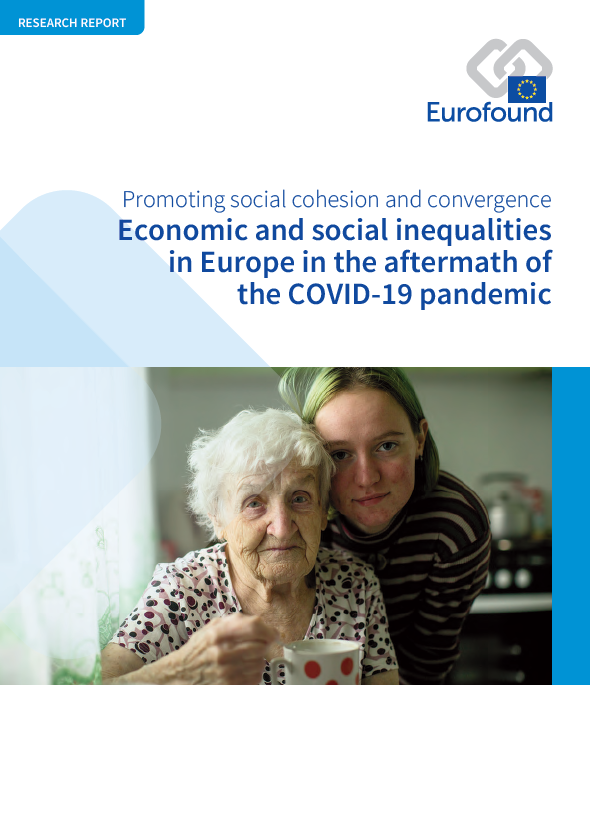
La pandemia di COVID-19 ha avuto effetti diversi sulle categorie sociali, a seconda degli svantaggi esistenti, ed è opinione diffusa che abbia innescato un incremento delle disuguaglianze in diversi ambiti della vita. Utilizzando gli indicatori del quadro di monitoraggio multidimensionale delle disuguaglianze dell’UE, la relazione mostra come è cambiata la disuguaglianza nell’ambito del reddito, della salute, dell’occupazione e dell’istruzione nel periodo intercorso tra il 2010 e il 2020. Esamina inoltre i principali fattori alla base di tale cambiamento durante la pandemia e analizza le relazioni tra le politiche governative in diversi ambiti e la disuguaglianza.
Key findings
Nel primo anno della crisi COVID-19 la disparità di reddito si è ridotta ulteriormente, confermando la fase di livellamento delle disuguaglianze nell’Unione europea (UE). Tuttavia, coloro che erano alla ricerca di un impiego e le persone con un livello di istruzione medio-basso erano più suscettibili di vedere decurtato il proprio reddito durante la pandemia. Tale situazione mette in evidenza il fatto che, sebbene in generale non sia stato riscontrato un ampliamento della disparità di reddito durante la COVID-19, sarà fondamentale che i responsabili politici monitorino attentamente la situazione a fronte dell’attuale crisi del costo della vita.
Salute e disparità di reddito sono strettamente legate: le persone nel quintile di reddito più basso hanno quasi il triplo delle probabilità di subire una disabilità rispetto a quelle del 20 % più alto. Durante la pandemia è aumentata anche la disuguaglianza relativa all’accesso ai servizi sanitari in base al reddito: nel 2020 il rischio di avere un’esigenza medica non soddisfatta per le persone nel quintile di reddito più basso era di 5,4 volte superiore a quello delle persone nel 20 % più alto, il che mette in luce come le politiche incentrate sulla riduzione della disparità di reddito siano anche in grado di ridurre le disuguaglianze sanitarie.
Dai risultati emerge che il lavoro da casa durante la pandemia può aver creato disuguaglianze tra le categorie a basso e ad alto reddito, in cui i lavoratori temporanei, i giovani e i precari si sono rivelati più vulnerabili alle crisi. Per assicurare l’arresto di tale tendenza nel mondo del lavoro sempre più flessibile dopo la pandemia di COVID-19, sarà fondamentale che i responsabili politici affrontino il lavoro precario e aumentino la trasparenza e la prevedibilità delle condizioni di lavoro.
Durante la pandemia la predisposizione di apparecchiature adeguate per l’apprendimento online ha avuto priorità rispetto al reddito, sottolineando l’importanza di affrontare il divario digitale e l’accesso alla tecnologia per tutti nel lungo periodo. Anche genitori e studenti che vivono in aree rurali e che non dovevano spostarsi come pendolari durante il periodo in esame erano più propensi a dichiararsi soddisfatti della qualità delle lezioni o dell’istruzione online rispetto a quelli che vivono in città.
La possibilità di lavorare da casa ha creato disuguaglianze tra categorie a basso e ad alto reddito accentuando la disuguaglianza di genere per quanto concerne cura dei figli e faccende domestiche. Nel 2020 le madri sole sono state le più propense a ridurre l’orario di lavoro a causa della chiusura delle scuole e delle strutture per l’infanzia: se le donne continuano a prestare assistenza non retribuita per più ore rispetto agli uomini, tale situazione rischierebbe di ampliare il divario retributivo di genere durante la ripresa.
The report contains the following lists of tables and figures.
List of tables
Table 1: Indicators selected for the income inequality analysis
Table 2: OLS regression model exploring the relationship between government spending and inequality in making ends meet according to education level
Table 3: Panel OLS regression exploring general drivers of income inequality (1995–2020), EU27
Table 4: OLS regression model exploring drivers of income inequality between rural and urban households
Table 5: OLS regression model exploring income inequality by individual characteristics
Table 6: Logistic regressions on income inequality by individual characteristics
Table 7: Indicators selected for the health inequality analysis
Table 8: OLS regression model exploring the relationship between government expenditure and inequality in chronic disease
Table 9: Multilevel logit regression model on worsening health between 2019 and 2020
Table 10: Multilevel logit regression models on worsening health and mental health between 2019 and 2020
Table 11: Indicators selected for the employment inequality analysis
Table 12: OLS regression model exploring the relationship between government expenditure and inequality in opportunity in having a white-collar job
Table 13: OLS regression model exploring the relationship between gender inequality in occupations, childcare and paid leave at country level
Table 14: OLS regression model exploring the relationship between gender inequality in being employed, childcare and paid leave at country level
Table 15: Random effects within–between model showing the relationship between gender inequality in employment, over time and between countries
Table 16: Multilevel linear regression model on the number of hours worked in 2019 and 2020
Table 17: Multilevel linear regression model on the change in the number of hours worked between 2018 and 2019 and between 2019 and 2020
Table 18: Indicators selected for inequality in education analysis
Table 19: OLS regression model exploring the relationship between government spending and inequality in PISA scores
Table 20: Determinants of respondents’ satisfaction with the quality of their children’s online schooling (multilevel ordered logit model)
List of figures
Figure 1: Dimensions of life of the EU MIMF
Figure 2: Intersectional approach to effects of COVID-19 on inequality
Figure 3: Macro-, meso- and micro-level factors in income inequality during the COVID-19 pandemic
Figure 4: Heatmap showing the results of income inequality indicators by country, 2018–2019, EU27 and the UK
Figure 5: Income quintile share ratio (S80/S20) for equivalised disposable income, EU27
Figure 6: Gini coefficient of equivalised disposable income, EU27, Bulgaria, Greece and Poland
Figure 7: Odds ratio of a household having problems making ends meet (with versus without a tertiary education, 2018) against spending on education (2015, % of GDP), EU27 and the UK
Figure 8: Odds ratio of a household having problems making ends meet (with versus without a tertiary education, 2018) against spending on social protection (2015, % of GDP), EU27 and the UK
Figure 9: Scatterplot of government spending on social protection (% of GDP at time t–1) relative to the Gini index of disposable income at time t (1995–2020), EU27
Figure 10: Odds ratio of households having problems making ends meet (rural versus urban, 2018) against public investments in agricultural R&D (2015, % of GDP), EU27 and the UK
Figure 11: Households that reported that their income decreased in 2020 compared with the previous year by country (%), selected Member States
Figure 12: Households containing people aged 50+ that received financial support from the government due to the pandemic by country (%), selected European countries
Figure 13: Recipients of pandemic-related government support by country, EU27 (%)
Figure 14: Macro-, meso- and micro-level factors in health inequality during the COVID-19 pandemic
Figure 15: Heatmap presenting the results of health inequality indicators, 2018–2019, EU27 and the UK
Figure 16: Map of odds ratios of people reporting unmet medical care needs (women versus men, adjusted), 2018
Figure 17: Heatmap of odds ratio of feeling depressed for different social groups, 2018–2019, EU27 and the UK
Figure 18: Risk ratios of having a severe long-standing limitation in usual activities (disability) due to a health problem for various social groups (2010–2020), EU27
Figure 19: Risk ratios of having an unmet medical need due to high cost, distance to travel or waiting lists for various social groups (2010–2020), EU27
Figure 20: Government spending on education in 2002 (% of GDP) relative to ex ante inequality of opportunity in having two or more chronic diseases in 2019 (aged 50+), EU27
Figure 21: Macro-, meso- and micro-level factors in inequality in working life outcomes during the COVID-19 pandemic
Figure 22: Heatmap showing results of working life inequality indicators, 2018–2019, EU27 and the UK
Figure 23: Risk ratios of gender inequality in various dimensions of working life (2002–2020), EU27
Figure 24: Risk ratios of unemployment rates among various social groups (2002–2020), EU27
Figure 25: Risk ratios of employment rates among various social groups (2002–2020), EU27
Figure 26: Odds ratio of women being in employment versus men (2019) against the share of children under three years of age in formal childcare (2019, %), EU27
Figure 27: Average number of weekly hours worked in 2020 by country and contract type, selected EU Member States
Figure 28: Proportion of women who held second or third jobs by household type, 2020 (%)
Figure 29: Macro-, meso- and micro-level factors in inequality in education and learning during the COVID-19 pandemic
Figure 30: Heatmap showing results of education inequality indicators, 2018–2019, EU27 and the UK
Figure 31: Difference in tertiary education attainment as a whole in 55- to 74-year-olds and those with parents with a lower than tertiary education (2021)
Figure 32: Trends regarding inequality in education between women and men (2002–2020), EU27
Figure 33: Risk and odds ratios of NEET rates between various social groups (2004–2020), EU27
Figure 34: Government spending on education (2013, % of GDP) against P90/P10 PISA scores in mathematics (2018), EU27 and the UK
Figure 35: Parents’ satisfaction with the quality of online schooling for their children, EU27 (%)
Figure 36: Parents’ satisfaction with the quality of their children’s online schooling depending on whether they worked from home or not during the pandemic, EU27 (%)
- Number of pages
-
102
- Reference nº
-
EF22002
- ISBN
-
978-92-897-2309-1
- Catalogue nº
-
TJ-07-23-019-EN-N
- DOI
-
10.2806/439913
- Permalink
Cite this publication
Eurofound (2023), Economic and social inequalities in Europe in the aftermath of the COVID-19 pandemic, Publications Office of the European Union, Luxembourg.
